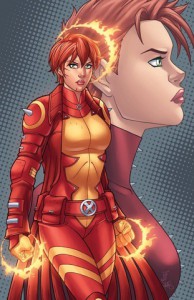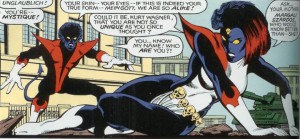As I’m about to take in X-Men: Days of Future Past in the cinema with my two best friends, I figured this an appropriate moment to glance back at the original source; the basis is for this new, big-scale X-Men movie extravaganza.
First published in standard comic-issue form in 1981, the Days of Future Past storyline spanned only two issues – Uncanny X-Men #141 and 142 – but has long been regarded as one of the classic and most influential stories in the X-Men canon.
In order to better enjoy the Days of Future Past movie in the present, the mind of the Burning Blogger is sent back, Kitty-like, to the year 1981 to revisit the classic source material…
The story, well known to even most people who haven’t read it, depicts a bleak future in which giant Sentinels rule and mutants are persecuted and kept in concentration camps, and from which the future Kitty Pryde’s ‘mind’ is propelled back in time to re-inhabit her younger self and prevent the assassination of Senator Kelly by Mystique and the Brotherhood of Evil Mutants.
Written by Chris Claremont, with art by John Byrne, those issues are still well worth reading for anyone who hasn’t – though I’m sure I’d be hard pressed to find an X-Men comic-book fan who hasn’t already read them in one of their various re-published collections over the years.
Now admittedly, given its age and given two-plus decades of subsequent storytelling and expansion of the X-Men mythology, those original comics don’t read all that brilliantly in 2014.
They’re still highly enjoyable, of course; but no masterful showcase for the art of comic- book storytelling or of comics as a great visual medium. It has some of the silly moments and cheesy lines that are common of comic books of the era; Wolverine’s “she looks like a kid, but she stands, talks, moves and smells like a woman” is a classic example of that.
It has some great moments too, however; I still love that first-page of #142, with its focus on Kitty’s mission. “This is a tale of two worlds and of the child-woman who sought to save them…” Classic.
In the end of course Kitty prevents Destiny from eliminating Senator Kelly. One of the enduringly great things about these two issues is that they were one of Kitty Pryde’s great showcases as a character and probably remain the storyline she is most renowned for, particularly for those who aren’t all that entrenched in the Excalibur run from the late 80s.
![]()
I still feel the film version of Kitty should be playing a more prominent role in this movie adaptation; but I admittedly haven’t seen the film yet.
Rather amusingly from our present standpoint is that the dystopian future portrayed in Uncanny X-Men #141 – 142 is set ‘far off’ in the year 2013 🙂 Not unlike Star Trek’s ‘Eugenics War’ being set in 1996, it becomes a harmlessly amusing reminder of how distant the year 2013 must’ve seemed to the writers in 1981 just as 1996 must’ve seemed a world away to the writers of the Star Trek Original Series episode ‘Space Seed’ in the sixties; the writers in both cases imagining those far-off dates as vastly more dramatic times than what we’ve actually experienced.
It may also be an indication that Chris Claremont may not have imagined the X-Men mythology still being relevant to people 25 years after he conceived the details of that story (the Star Trek writers certainly wouldn’t have imagined that by the time of the real 1996 Star Trek would still be something that mattered).
This much time later – shit, I had pretty much only just been born when those issues came out – the biggest legacy of Uncanny X-Men #141 – 142 is how much it has been revisited and how many subsequent stories it has spawned over the years, particularly around Rachel Summers.
The subsequent existence of such essential X-Men players as Cable and Stryfe – or more recently someone like Hope Summers – can be said to have been massively influenced by the original 1981 story and the X-Men comics’ subsequent fascination with dystopian futures and alternate timelines.
It could even be said to have been a big influence on the tone and nature of something as monumental as 1995’s Age of Apocalypse event.
That’s something to be grateful to the original story for. Here are five more things to be grateful for…

- It gave us Rachel Summers. One of the many underrated, under-used characters that populate the vast X-Men world. Rachel – the future child of Scott Summers and Jean Grey – plays only a brief part in the 1981 two-part story, but it’s a great place to have started her fictional life. Though she is pretty much ‘last man standing’ in the future world depicted in Uncanny #142, Rachel Summers does not feature in the Days of Future Past movie version. She has had a convoluted, non-linear, time-travel-addled fictional life to say the least. Admittedly I don’t have a firm enough handle on all the ins and outs of her convoluted history; but for those interested, I refer you to these guys.
- It was the inspiration for Wolverine and the X-Men. Or at least in large part the original 1980 story was a big influence on the central plot device of this rather good animated series that ran in 2009. The animated series, however, though taking elements from the original story, tailored it massively into something different. I also recently re-watched the version of the story adapted for the classic 90’s X-Men animated series, which replaces Kitty Pryde with Bishop as the time-travelling main character.
- That famous image of all the graves. It is one of the best-known single images in the long mythology of X-Men comics; that simple shot early in #141 with Kitty walking passed the array of long-fallen X-Men’s gravesites. That Sentinel cover of Uncanny #142 is also one of the classic, best-remembered in a vast pantheon of memorable X-Men covers.
- A great roll-call, a great use of characters; the wheelchair-bound, ‘good guy’ Magneto in the future, foreshadowing perhaps Claremont’s long-term evolving of Magneto’s character from cartoon-like villain to real character-of-substance. And then we’ve got Rachel Summers, Mystique, Pyro, Destiny and the Blob too! Even Sebastian Shaw. It also gives us the first reference to “Project Wideawake”, which would reverberate through the X-Men comics for years and years to come.
- The encounter between Nightcrawler and Mystique. Nothing explosive or particularly well-written happens, but it’s a memorable moment, given much later revelations about Nightcrawler’s origins. Even here, all the way back 1980 the set-up was there in Kurt’s first impressions of Raven.

Whether the Days of Future Past movie is to be added to the things we should be grateful to the original comics for remains to be seen – opinion, in any case, will obviously vary. It is certainly a massive part now of that legacy anyway.
We can complain about the film taking massive liberties with the original story details, but it’s an old argument by now, especially given that the animated adaptations have done the same thing.
My own (limited) powers of foresight tell me this movie is going to justify the excitement…




